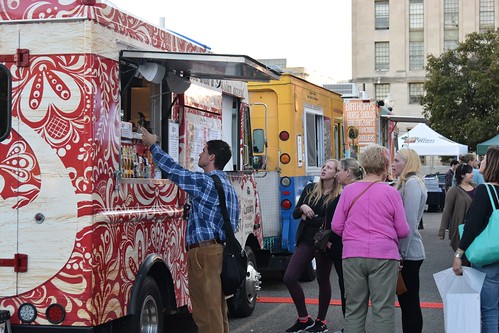
Our own USDA Farmers Market, brought to you by USDA’s Agricultural Marketing Service (AMS), celebrated 20 years of offering Washington, DC access to farm-fresh products this year.
USDA is always looking for innovative ways to help farmers markets succeed and experiment with ways that might help them expand. So this season we added evening hours on the third Friday of every month to the USDA Farmers Market. Local news outlets like The Washington Post and blogs like BYT DC shared our excitement for the first ever USDA Farmers Market at Night.
To help farmers market managers across the country, we want to share the Top Five Lessons Learned from this pilot project.
1. Find the Right Theme. Each market featured a unique theme. The best results were from themes that really connected with customers. The more food focused themes easily attracted customers.
- Explore DC: Walk, Run, Ride coincided with DC’s Bike to Work Day, and focused on keeping active and healthy eating.
- DC Favorites Night featured DC’s iconic dishes and favorite local eateries and food trucks and Hot & Cold featured spicy food (hot) and cold foods.
- The County Fair in August highlighted the light-hearted harvest celebrations. The market also featured some healthy alternatives to traditionally county fair foods.
- The least successful night market theme was Back to School Night. Perhaps many adults are past the back to school mindset by September or many customers may not be parents.
- We ended with a warm serving of Simply Soup, drawing customers in with the theme of communal tables and sharing all kinds of cuisines.
2. Build Strong Partnerships. The relationships and partnerships we built really brought the USDA Farmers Market at Night to life. We worked to make connections both within USDA and the surrounding community. From working with local government and businesses to non-profits to restaurants and hotels, we partnered with over 75 local organizations and businesses. We also booked six musical acts and 31 food trucks from the DMV Food Truck Association. Our founding partner, the local DC-based food incubator Union Kitchen, worked with us to give 15 local food businesses an opportunity to test and sell their products each month.
3. Identify & Recognize the Challenges of Recruiting Farmers. Recruiting farmers for the market was a challenge. A major concern by vendors was typically the Saturday morning commitments they had already made. Saturdays and Sundays are the most popular time for farmers markets around the country, providing farmers the best opportunity to sell their inventory. Some farmers also expressed concerned they would not have enough inventory for a Friday night market and their regular weekend market. Others had the same crews for harvest and transportation, limiting the number of people they had available to harvest and pack products for the additional market. Another concern was rush hour traffic to and from the city, as well as the summer beach traffic for those coming from further south and east.
4. Connect with the Community. Our night market focused on the community. We worked with our partners to brainstorm about what was missing from Friday evenings on the National Mall. How could this market be a destination for tourists visiting the area as well as local DC residents to relax and enjoy month after month? The answer was simply to get the word out and the community you build will spread the word for you. We really concentrated on creating an experience that our customers valued and many came back at the next opportunity.
5. Find New Approaches. There can be a lot of hurdles when starting a new project. We made adjustments along the way if something didn’t seem to work and encouraged vendors to do the same. For example, we shifted the location of the musicians so that the music was more likely to drift out to the National Mall, enticing more tourists to join the market. We also experimented with the placement of food trucks. Every two months the location of the trucks was changed. We tried mixing the trucks between vendor tents and lining them up in the center of the market, which customers seemed to respond to the best. Vendors who were flexible and responsive increased their sales significantly. The visitors to the night market included tourists and office workers looking for ready-to-eat offerings. The most successful of our farm producers where those whom converted a significant portion of their products to value-added, ready-to-eat products.
Throughout December, be sure to follow #HighFive to see just what we’ve been up to in the last 12 months, and stay tuned as we look forward to a 2016 that promises to be better than ever.




